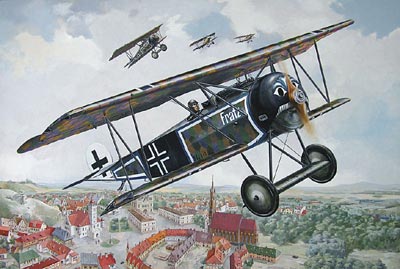
‘Filling the ranks, standing in the gap’
At the First Fighter Competition at Adlershof in January 1918 it was decided to manufacture the Fokker D.VI as a move to insure enough rotary engine fighters would be available for front line operations. Since the Oberursel Ur.III 145hp and the Goebel Goe III 160hp or the Siemens-Halske Sh III 160-220hp were still in short supply due to production concerns, the Fokker V.9 with an engine change to the very reliable Oberursel Ur.II 120hp was chosen to go into production. Make no mistake, while there are physical similarities between the Fokker company’s Dr.I and the D.VI, one was not developed from the other. Like any engineering concern the Fokker designers had formulas that they used for aircraft specifications, especially concerning the type and weight of an installed motor in an airframe. The closest similarity to the D.VI (rotary) is the D.VII (inline six.) Fokker built one for type testing in the ‘low altitude operations class’ and one for ‘higher altitude operations class.’ The Fokker D.VI was to make up the partial compliment of Jagdstaffel 80b. In Jasta 64w (Fokker D.VI 1679/18), Kest 4b (Fokker D.VI 1648/18 ? ) and in Kest 1a, single examples were used for rotary engine familiarization flights by its pilots. These units were designated to receive the new Pfalz D.VIII with the Sh III 160-220hp and had been flying Albatros D.Va types with worn-out inline six Mercedes D.IIIaü 180hp.
It was on a night as cold as a money lender’s heart, deep in the Ukraine, during the worst blizzard in 100 years, an icy wind tore across the massive frozen lake surrounding castle Roden. Its deep howl was like that of a prehistoric black wolf from the high frozen Steppes. In the laboratory at the top of the old weather beaten west tower, the black robed, design wizards huddled over a boiling cauldron and poured liquid styrene into their newest molds. In the eerie half light of the whirring, hissing and sparking- high voltage machinery, magic wands are waved, switches are thrown and an gnarled and twisted hand spreads techno-dust in to the bubbling soup. Then a gaunt, pale, half crazed figure in a medical smock steps up to the mold box and holds his stethoscope to the outer casing. As he listens he commands, “. . .SILENCE!” A minion wizard turns to the aged 1913 Philco radio and turned down the amp-ed up blasts of “Manheim Steamroller.” Moments later, suddenly, the doctor cries out, “. . .Its Alive!!! . . . its alive!!! Thus another scale wonder is borne in to this world.

In recent years interest in larger 1/32 scale WWI aircraft kits has flourished. This is possibly due to the fact that the youngsters that were building 1/72 scale in the 1960's are struggling with changing eyesight due to age. We are a stubborn lot, we fanatics of the first world war flying machines. That is what we like to build. Fortune smiles on us with the out put of Roden of the Ukraine. This kit review will deal specifically with their Roden Fokker D.VI kit # 603. Roden’s all plastic kits seem to be aimed at the average modeler with an eye for detail. Begin by a thorough clean up of all parts in warm water and dish soap, scrub ( use an old toothbrush) and rinse thoroughly. Antibacterial soap is a good idea when using acrylic paints.




















